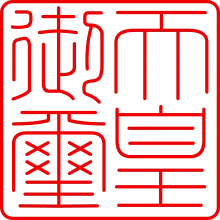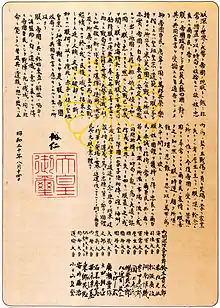Privy Seal of Japan
The Privy Seal of Japan (御璽, Gyoji) is one of the national seals and is the Emperor of Japan's official seal.
| Privy Seal of Japan | |
|---|---|
 | |
| Adopted | Nara period |
| Motto | Tennō/Gyoji (天皇御璽, "The Emperor's Imperial Seal")
天皇 |

Description
The Privy Seal of Japan is square, and its inscription 天皇御璽 ("The Emperor's Imperial Seal") is written in seal script (篆書, tensho). It has two lines of vertical writing, with the right-hand side containing the characters 天皇 (Tennō, Emperor), and on the left-hand side containing the characters 御璽 (Gyoji, Imperial seal).
The present Privy Seal is made of pure gold and is about 3 sun (about 9 cm) in size and weighs 4.5 kg. The master-hand of the seal was Abei Rekido (安部井 櫟堂, 1805-1883) of Kyoto. He was commissioned to manufacture the State Seal of Japan within one year, in 1874 (Meiji 7).
When not in use, the seal is kept in a leather bag. The seal is used with special cinnabar seal ink specially made by the National Printing Bureau.
Use
The Privy Seal of Japan is printed on Imperial rescripts, proclamation of sentences of laws, cabinet orders, treaties, instruments of ratification, ambassadors' credentials and their dismissal documents, documents of general power of attorney, consular commissions, letters authorizing foreign consuls, letters of appointment or dismissal of government officials whose appointment requires the Emperor's attestation, and appointment documents and documents of the Prime Minister and Chief Justice, and their respective dismissals.[1]
At the 2019 Japanese imperial transition, the Privy Seal – together with the State Seal and two of the Imperial Regalia – featured twice during the ceremonies: During the abdication of Emperor Akihito on 30 April, and during the accession of Emperor Naruhito on 1 May, chamberlains carried the seals into the Hall of Pines, where they were placed on tables near the reigning Emperor.[2][3][4][5]
History
The history of the Privy Seal of Japan dates back to the Nara period. Although it was originally made from copper, it was manufactured from stone in 1868 (Meiji) and later, was made from pure gold.
If the State Seal or the Privy Seal are illegally reproduced, the penalty is at least two years or more of terminable penal servitude according to the first clause of Article 164 of the Criminal Code of Japan.[6]
See also
References
- "The Privy Seal and State Seal". Imperial Household Agency. Retrieved 8 December 2015.
- "Japan's emperor prays for peace in first abdication in 200 years". Reuters. 30 April 2019. Retrieved 1 May 2019.
- "Government to present new era name to Emperor and Crown Prince before April 1". The Japan Times. 3 February 2019. Retrieved 20 February 2019.
- "Government to designate May 1, day of new Emperor's accession, as public holiday, creating 10-day Golden Week in 2019". The Japan Times. 12 October 2018. Retrieved 20 February 2018.
- Tajima, Nobuhiko (17 January 2019). "Emperor to give final speech at abdication ceremony". Asahi Shimbun. Retrieved 20 February 2019.
- "刑法 / Penal Code".
_-_East_Asian_and_Vietnamese_seal_sample_(2021)_01.png.webp)